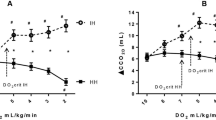Summary
-
1.
The respiration ofOctopus vulgaris was investigated, particular attention being given to the role of the blood in the uptake and transport of oxygen. Measurements were made on free moving animals. Oxygen consumption was recorded and blood sampled with indwelling cannulae in pre and post branchial (aortic) vessels.
-
2.
In normoxia the mean values for circulating bloodP O 2 are 78.1±2.9 mmHg for arterial and 30.0±3.2 mmHg for venous blood. The hemocyanin in arterial blood is 98% saturated and 14% saturated in venous blood. There is a 0.11 pH unit decrease between arterial and venous blood.
-
3.
The in vitro Bohr coefficient has a value of −1.58 Δlog10 P 50/Δ pH.
-
4.
In hypoxia the oxygen consumption declined markedly below an ambientP O 2 of 90 mmHg.
-
5.
Hypoxia was accompanied by a decline in aorticP O 2 but a near mainstenance of arterial hemocyanin saturation so that the arterial to venous difference declined by only 17% between normoxia and the most acute hypoxia. A marked increase in hemocyanin oxygen affinity occurred with a rise in blood pH. The large Bohr factor of the blood may be a major adaptation to hypoxic conditions, while bradycardia and modulations of stroke volume may play only a small part.
Similar content being viewed by others
References
Borer KT, Lane CE (1971) Oxygen requirements ofOctopus briareus Robson at different temperatures and oxygen concentrations. J Exp Mar Biol Ecol 7:263–269
Burnett LE (1979) The effects of environmental oxygen levels on the respiratory function of hemocyanin in the spider crab,Libinia emarginata, and the ghost crab,Ocypode quadrata. J Exp Zool 210:289–299
Butler PJ, Taylor EW, McMahon BR (1977) Respiratory and circulatory changes in the lobster (Homarus vulgaris) during long term exposure to moderate hypoxia. J Exp Biol 73:131–146
Cameron JN (1971) Rapid method for determination of total carbon dioxide in small blood samples. J Appl Physiol 31:632–634
Hazelhoff EH (1938) Über die Ausnutzung des Sauerstoffs bei verschiedenen Wassertieren. Z Vergl Physiol 26:306–327
Henze M (1910) Über den Einfluss des Sauerstoffdrucks auf den Gaswechsel einiger Meerestiere. Biochem Z 26:255–278
Johansen K (1965) Cardiac output in the large cephalopodOctopus dofleini. J Exp Biol 42:475–480
Johansen K, Lenfant C (1966) Gas exchange in the cephalopod,Octopus dofleini. Am J Physiol 210:910–918
Johansen K, Redmond JR, Bourne GB (1978) Respiratory exchange and transport of oxygen inNautilus pompilius. J Exp Zool 205:27–36
Johansen K, Brix O, Lykkeboe G (1982) Blood gas transport in the cephalopod,Sepia officinalis. J Exp Biol (in press)
Lenfant C, Johansen K (1965) Gas transport by the hemocyanin containing blood of the cephalopodOctopus dofleini.Am J Physiol 209:991–998
Lykkeboe G, Johansen K (1981) A cephalopod approach to rethinking about the importance of the Bohr and Haldane effects. Pacific Science (in press)
Lykkeboe G, Brix O, Johansen K (1980) Oxygen-linked CO2 binding independent of pH in cephalopod blood. Nature 287:330–331
Maginnis LA, Wells MJ (1969) The oxygen consumption ofOctopus cyanea. J Exp Biol 51:607–613
McMahon BR, Butler PJ, Taylor EW (1978) Acid-base changes during recovery from disturbance and during long term hypoxic exposure in the lobsterHomarus vulgaris. J Exp Zool 205:361–370
Truchot JP (1971) Fixation de l'oxygène par le serum deCarcinus maenus (L.) (Crustacé Decapode Brachyoure). CR Acad Sci [D] (Paris) 272:984–987
Tucker VA (1967) Method for oxygen content and dissociation curves on microliter blood samples. J Appl Physiol 23:410–414
Wells MJ (1979) The heartbeat ofOctopus vulgaris. J Exp Biol 78:87–104
Author information
Authors and Affiliations
Rights and permissions
About this article
Cite this article
Houlihan, D.F., Innes, A.J., Wells, M.J. et al. Oxygen consumption and blood gases ofOctopus vulgaris in hypoxic conditions. Journal of Comparative Physiology B 148, 35–40 (1982). https://doi.org/10.1007/BF00688885
Accepted:
Issue Date:
DOI: https://doi.org/10.1007/BF00688885



